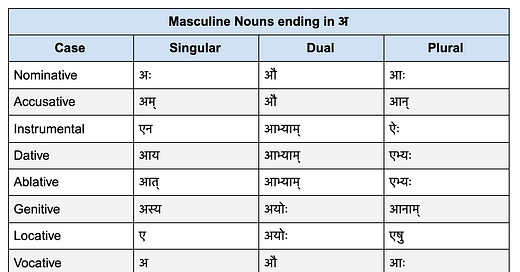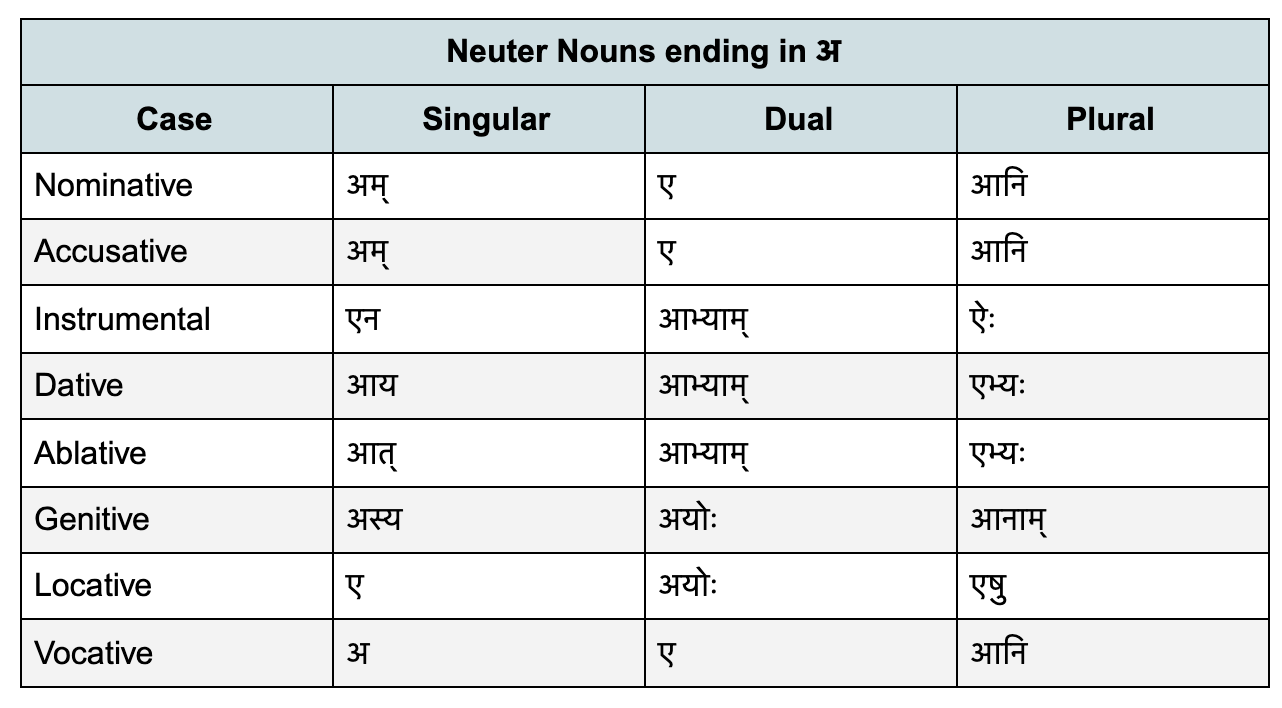The first time I learned about Sanskrit Declensions, I was beyond confused. I didn’t understand that this was for nouns and not some weird conjugation of verbs I’ve never heard of. So I was super grateful when Dr. Bhaswati Bhattacharya sat down with me and explained it in much simpler terms, which I will share here.
First, the declensions are as follows for Masculine, Neuter, and Feminine Nouns ending in अ / आ:
For the full list of endings with इ / ई, उ / ऊ, ऋ, -अन or -अस् and more, you can take a look at the virginia.edu website here.
So what are these noun declensions even? Dr. Bhaswati explained to me that they are a way to put any noun into different parts of a sentence. When we look at a noun as it relates to other words, we use prepositions. For example: “with the” “by the” “in the” “toward” “from the” “for the”. In Sanskrit, these relational terms are put after the word, as post-positions.
So let’s go through each case:
Nominative
The nominative form refers to the main name or subject of the sentence. For example, in the sentence “The girls are reading”, the subject of the sentence is “the girls”. So the word बालिका or girl in Sanskrit will have the post-fix आः added as follows:
बालिकाः पठन्ति (बालिका => बालिकाः) - The girls are reading
Accusative
The accusative refers to the object of the sentence. In the sentence “the teacher eats an apple”, the apple is the object, so the word apple आताफल will have the neuter singular post-fix अम् added:
शिक्षकः आताफलं खादति (आताफल => आताफलम्) - The teacher eats an apple
Instrumental
The instrumental form refers to with / by / through the instrument that the subject uses to accomplish an action. “The artist draws with a pencil” - the pencil is the instrument that the artist uses to accomplish the act of drawing. In Sanskrit, a drawing pencil is वर्णलेखनी, a female word ending with ई, so the ending that needs to be added is इया as follows:
चित्रकार: वर्णलेखनिया चित्रणम् करोति (वर्णलेखनी => वर्णलेखनिया) - The artist draws with a pencil”
Dative
Dative refers to for / toward / to the noun. For example, “the singer sings for the boys”. Here, the boys is the noun “for” whom the singer sings. So we add the masculine plural ending एभ्यः to the word boy बाल as follows:
गायकः बालेभ्यः गायति (बाल => बालेभ्यः) - The singer sings for the boys
Ablative
Ablative is the opposite direction of Dative - away from / from instead of toward / to. “The girl takes the book from the library”. Here, “from the library” is the ablative form. The word library in Sanskrit is male पुस्तकालय. So we add the male ablative post-fix आत् as follows:
बालिका पुस्तकम् पुस्तकालयात् स्वीकरोति (पुस्तकालय => पुस्तकालयात्) - The girl takes the book from the library
Genitive
The genitive case refers to possession - belonging to / of. It is attached to the object that is owned. “This is the politician’s car” - we add the male genitive ending अस्य to the word politician नीतिज्ञः in Sanskrit:
इयं नीतिज्ञस्य वाहनम् (नीतिज्ञः => नीतिज्ञस्य) - This is the politician’s car
Locative
The locative form refers to location - on / in / under / inside in relation to the noun. “The student studied in the library” - here, “in the library” is the locative form. The Sanskrit term for library ग्रन्थालय changes to a masculine locative ending ए as follows:
छात्रः ग्रन्थालये पठति (ग्रन्थालय => ग्रन्थालये) - The student studied in the library
Vocative
The vocative case is used to address someone. Let’s say you’re summoning a taxi - “Hey Driver, come here!” - you’re addressing the driver. So the word driver वाहकः will have the masculine vocative ending अ as follows:
अये वाहक! अत्र आगच्छतु! (वाहकः => वाहक) - Hey Driver, come here!"
Conclusion
While noun declensions are at first confusing, if you think about it, it’s pretty cool. It means that the sentences can be arranged in a different order, but you’ll be able to easily tell the subject, object, and any other noun relationship just from its post-fix! After you memorize all the ending first of course… which is the hard part!






